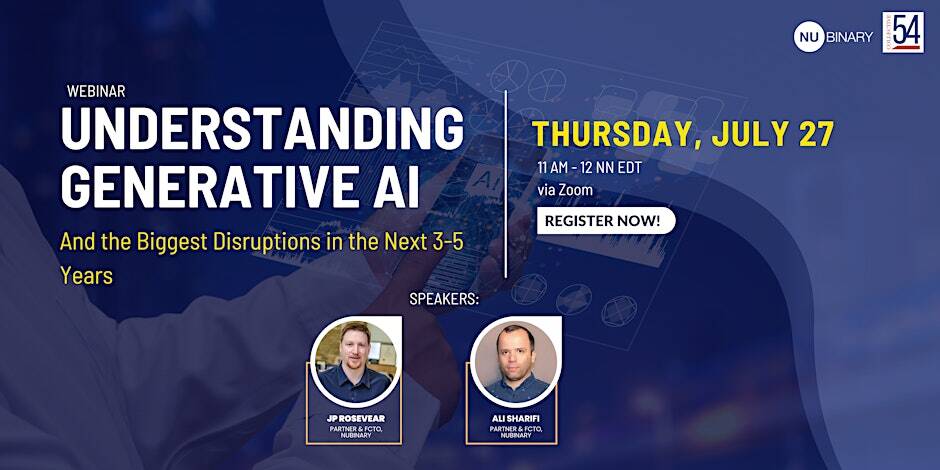Webinar Recap: Understanding Generative AI and the Biggest Disruptions for the Next 3-5 Years

AI has been advancing in leaps and bounds, and generative AI sits at the apex of this new technological frontier. In a recent insightful webinar hosted by NuBinary, esteemed industry leaders JP Rosevear and Ali Sharifi dived deep into the evolving landscape, current state, and potential future of generative AI. Their in-depth discussion illuminated the complex intricacies of this technology and its potential to instigate massive disruptions in the next 3-5 years.
What is Generative AI?
The session started with a foundational question: “What is generative AI?” Ali Sharifi and JP Rosevear explained that generative AI models, like GPT-3, are designed to generate content. They are not simply predicting outcomes based on historical data but producing entirely new data. They can write articles, create images, simulate human speech, and even write software codes.
Current State of Generative AI
Moving on, the webinar discussed the current state of generative AI. Experts showcased how this technology is creating impressive pieces of art, music, writing, and design. Remarkably, the generated content is becoming increasingly indistinguishable from that created by humans, proving just how far generative AI has come. This technology isn’t confined to the realms of art and creativity; businesses are using it to enhance their operations, from customer support bots to auto-generated articles and blogs.
How Does Generative AI Work?
Following an engaging discussion on present-day applications, the conversation turned technical. Delving into how generative AI works, the speakers introduced the concept of machine learning, particularly deep learning. They described how AI models, like GPT-3, use enormous datasets to learn patterns and nuances in human language. By using such techniques as reinforcement learning and transformer models, these machines are trained to generate their own content.
As the discussion advanced, JP Rosevear presented a deep dive into Large Language Models (LLMs), specifically two types: base LLMs and instruction-tuned LLMs.
Base LLMs predict the subsequent word, creating inferences from the input. In contrast, instruction-tuned LLMs utilize long-lived instructions to generate output, potentially serving as a legal advisor or marketing content generator.
Expounding on LLMs capabilities, JP enumerated four main use cases:
- Summarizing: LLMs condense large texts into shorter summaries.
- Inferring: They identify sentiments or topics within a text, offering deeper insights.
- Transforming: LLMs can translate languages, adjust tone, convert formats, or proofread texts.
- Expanding: They can elaborate on given ideas or concepts.
These capabilities showcase generative AI’s transformative potential, even as we only begin to explore the technology’s full capabilities. As AI progresses, so will our application of these models, paving the way for more advanced and diverse uses.
Future of Generative AI
Last but certainly not least, the webinar focused on the future of generative AI. In the next 3-5 years, the experts predicted significant disruption in various industries. They anticipate a rise in personalized content, from tailor-made news articles to custom recommendations. Furthermore, we can expect an expansion of generative AI into more fields, like education and healthcare.
However, the future is not without its challenges. Key issues like data privacy and AI ethics were discussed at length. Experts emphasized the need for transparency and oversight to prevent misuse and protect user data. Ultimately, the future of generative AI will require a careful balance of innovation and regulation.
Ali Sharifi, while acknowledging the many challenges associated with adopting AI, indicated that these issues would be addressed comprehensively in a follow-up webinar in August. He drew attention to a Stanford study that highlighted an increase in AI controversies alongside a rise in AI job opportunities.
“As you can see in this chart, the number of AI controversies is definitely getting higher and higher. But, at the same time, the number of AI jobs is also increasing. This indicates that although AI has its problems, the general sentiment around AI remains quite positive,” – Ali Sharifi

Source: https://hai.stanford.edu/news/2023-state-ai-14-charts
In looking forward, Ali pointed out that the volume of data, not just text, but also audio, image, and video, is set to grow exponentially. “From a dataset perspective, we’re going to have more and more data generated,” he stated, projecting an explosion in data based on market predictions.
In essence, while AI, and generative AI in particular, offers lucrative opportunities and has a positive outlook, it is crucial to navigate the challenges responsibly. This includes dealing with controversies, managing an ever-increasing volume of data, and maintaining ethical standards. The webinar made it clear that these challenges would continue to shape the trajectory of generative AI, emphasizing the importance of preparing for these realities as we step into the future.
Conclusion
In conclusion, the webinar provided a comprehensive overview of generative AI, from its foundations to its future. As the technology evolves, it will be fascinating to see how these predictions play out and what other surprises generative AI has in store. The webinar was a call to all stakeholders, from researchers to policymakers, to embrace this exciting new technology and harness its potential responsibly. For the second webinar, we will focus on understanding AI disruption and how businesses can prepare and maintain their business competitive edge and relevance. Register here to join the next webinar on August 16, 2023, at 11 AM – 12 PM EDT.
How can NuBinary Help with Your Company’s AI Adoption?
NuBinary can help your company with AI strategy and through the entire software development lifecycle. Our CTOs are capable of figuring out the best technology strategy for your company. We’ve done it several times in the past, on a big range of different startups, and have all the necessary knowledge and tools to keep your development needs on track, either through outsourcing or hiring internal teams.
Contact us at info@nubinary.com for more information or book a meeting to meet with our CTOs here.
About the Speakers:
JP Rosevear, co-founder and CTO at NuBinary, has an extensive 25-year career in the industry, with a background spanning startups to large enterprises. JP has held leadership roles in esteemed companies like Nova (Polar), Novell, and Mozilla, giving him a wide range of experience in the tech field. His work as a Fractional CTO has led to successful collaborations with numerous startups, such as PUSH, which successfully exited to WHOOP in 2021. Known for building high-performing teams and nurturing scalable, repeatable technology development processes, JP’s insights are invaluable for businesses aiming to innovate and grow.
Ali Sharifi, also a co-founder and CTO at NuBinary, is a distinguished tech executive boasting over 15 years of extensive experience in the realms of security and machine learning. With a strong track record in ensuring compliance and shaping the future of technology, Ali’s work is globally recognized. His role at NuBinary involves providing cutting-edge solutions to companies’ technical and operational needs, and his expertise has helped organizations achieve regulatory compliance and drive innovation. Notably, Ali’s academic contributions as a Professor and Principal Investigator have significantly influenced the development of various fields, from security and privacy to machine learning and sustainability measurement.
With their combined expertise, JP Rosevear and Ali Sharifi guided an engaging discussion on generative AI, painting a comprehensive picture of its evolution, current state, and future.

%20-Aug%2016th-1.png)

